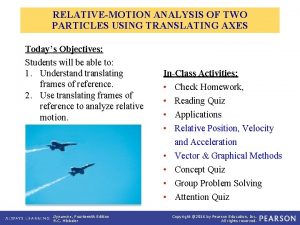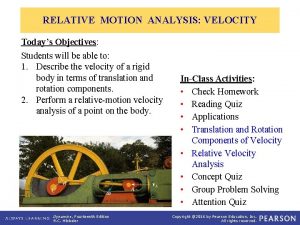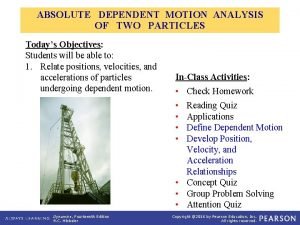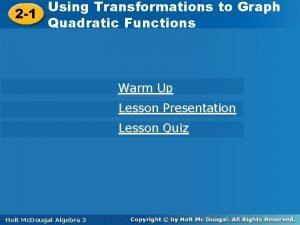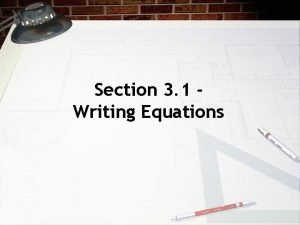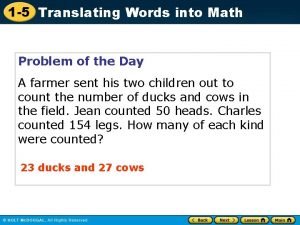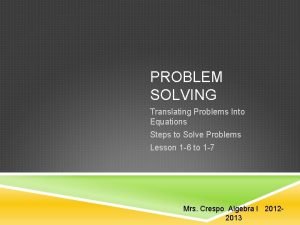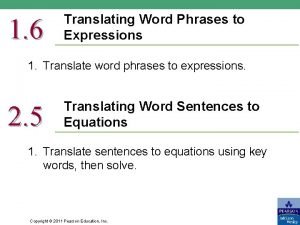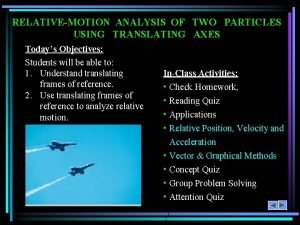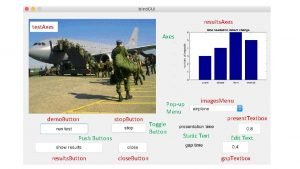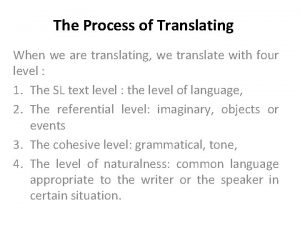RELATIVEMOTION ANALYSIS OF TWO PARTICLES USING TRANSLATING AXES


















- Slides: 18

RELATIVE-MOTION ANALYSIS OF TWO PARTICLES USING TRANSLATING AXES Today’s Objectives: Students will be able to: 1. Understand translating frames of reference. 2. Use translating frames of reference to analyze relative motion. Dynamics, Fourteenth Edition R. C. Hibbeler In-Class Activities: • Check Homework, • Reading Quiz • Applications • Relative Position, Velocity and Acceleration • Vector & Graphical Methods • Concept Quiz • Group Problem Solving • Attention Quiz Copyright © 2016 by Pearson Education, Inc. All rights reserved.

READING QUIZ 1. The velocity of B relative to A is defined as A) v. B – v. A. B) v. A – v. B. C) v. B + v. A. D) v. A + v. B. 2. Since two-dimensional vector addition forms a triangle, there can be at most _____ unknowns (either magnitudes and/or directions of the vectors). A) one C) three Dynamics, Fourteenth Edition R. C. Hibbeler B) two D) four Copyright © 2016 by Pearson Education, Inc. All rights reserved.

APPLICATIONS When you try to hit a moving object, the position, velocity, and acceleration of the object all have to be accounted for by your mind. You are smarter than you thought! Here, the boy on the ground is at d = 10 ft when the girl in the window throws the ball to him. If the boy on the ground is running at a constant speed of 4 ft/s, how fast should the ball be thrown? Dynamics, Fourteenth Edition R. C. Hibbeler Copyright © 2016 by Pearson Education, Inc. All rights reserved.

APPLICATIONS (continued) When fighter jets take off or land on an aircraft carrier, the velocity of the carrier becomes an issue. If the aircraft carrier is underway with a forward velocity of 50 km/hr and plane A takes off at a horizontal air speed of 200 km/hr (measured by someone on the water), how do we find the velocity of the plane relative to the carrier? How would you find the same thing for airplane B? How does the wind impact this sort of situation? Dynamics, Fourteenth Edition R. C. Hibbeler Copyright © 2016 by Pearson Education, Inc. All rights reserved.

RELATIVE POSITION (Section 12. 10) The absolute positions of two particles A and B with respect to the fixed x, y, z-reference frame are given by r. A and r. B. The position of B relative to A is represented by r. B/A = r. B – r. A Therefore, if r. B = (10 i + 2 j ) m and r. A = (4 i + 5 j ) m, then r. B/A = r. B – r. A = (6 i – 3 j ) m. Dynamics, Fourteenth Edition R. C. Hibbeler Copyright © 2016 by Pearson Education, Inc. All rights reserved.

RELATIVE VELOCITY To determine the relative velocity of B with respect to A, the time derivative of the relative position equation is taken. v. B/A = v. B – v. A or v. B = v. A + v. B/A In these equations, v. B and v. A are called absolute velocities and v. B/A is the relative velocity of B with respect to A. Note that v. B/A = - v. A/B. Dynamics, Fourteenth Edition R. C. Hibbeler Copyright © 2016 by Pearson Education, Inc. All rights reserved.

RELATIVE ACCELERATION The time derivative of the relative velocity equation yields a similar vector relationship between the absolute and relative accelerations of particles A and B. These derivatives yield: a. B/A = a. B – a. A or a. B = a. A + a. B/A Dynamics, Fourteenth Edition R. C. Hibbeler Copyright © 2016 by Pearson Education, Inc. All rights reserved.

SOLVING PROBLEMS Since the relative motion equations are vector equations, problems involving them may be solved in one of two ways. For instance, the velocity vectors in v. B = v. A + v. B/A could be written as two dimensional (2 -D) Cartesian vectors and the resulting 2 -D scalar component equations solved for up to two unknowns. Alternatively, vector problems can be solved “graphically” by use of trigonometry. This approach usually makes use of the law of sines or the law of cosines. Could a CAD system be used to solve these types of problems? Dynamics, Fourteenth Edition R. C. Hibbeler Copyright © 2016 by Pearson Education, Inc. All rights reserved.

LAWS OF SINES AND COSINES Since vector addition or subtraction forms a triangle, sine and cosine laws can be applied to solve for relative or absolute velocities and accelerations. As a review, their formulations are provided below. C b a B A c Law of Sines: a sin A Law of Cosines: b = sin B c = sin C a 2 = b 2 + c 2 - 2 bc cos A 2 2 b = a + c 2 2 2 - 2 ac cos B 2 c = a + b - 2 ab cos C Dynamics, Fourteenth Edition R. C. Hibbeler Copyright © 2016 by Pearson Education, Inc. All rights reserved.

EXAMPLE Given: Two aircraft as shown. v. A = 650 km/h v. B = 800 km/h Find: v. B/A Plan: 1) Vector Method: Write vectors v. A and v. B in Cartesian form, then determine v. B – v. A 2) Graphical Method: Draw vectors v. A and v. B from a common point. Apply the laws of sines and cosines to determine v. B/A. Dynamics, Fourteenth Edition R. C. Hibbeler Copyright © 2016 by Pearson Education, Inc. All rights reserved.

EXAMPLE (continued) Solution: 1) Vector Method v. A = (650 i ) km/h v. B = – 800 cos 60 i – 800 sin 60 j = ( – 400 i – 692. 8 j) km/h v. B/A = v. B – v. A = (– 1050 i – 692. 8 j) km/h v. B /A = = (-1050)2 +(-692. 8)2 = 1258 km/h tan-1( 692. 8 ) = 33. 4 1050 Dynamics, Fourteenth Edition R. C. Hibbeler Copyright © 2016 by Pearson Education, Inc. All rights reserved.

EXAMPLE (continued) 2) Graphical Method: Note that the vector that measures the tip of B relative to A is v. B/A. 650 km/h v. A 800 km/h 120 v. B/A Law of Cosines: (v. B/A)2 = (800) 2 + (650) 2 − (800) (650) cos 120 v. B/A = 1258 km/h Law of Sines: v. B/A sin(120 ) Dynamics, Fourteenth Edition R. C. Hibbeler = v. A sin or = 33. 4 Copyright © 2016 by Pearson Education, Inc. All rights reserved.

CONCEPT QUIZ 1. Two particles, A and B, are moving in the directions shown. What should be the angle q so that v. B/A is minimum? A) 0° B) 180° C) 90° D) 270° v. B = 4 ft/s B v. A= 3 ft/s A 2. Determine the velocity of plane A with respect to plane B. A) (400 i + 520 j ) km/hr B) (1220 i - 300 j ) km/hr 30 C) (-181 i - 300 j ) km/hr D) (-1220 i + 300 j ) km/hr Dynamics, Fourteenth Edition R. C. Hibbeler Copyright © 2016 by Pearson Education, Inc. All rights reserved.

GROUP PROBLEM SOLVING Given: Car A moves in a straight line while Car B moves along a curve having a radius of curvature of 200 m. v. A = 40 m/s v. B = 30 m/s a. A = 4 m/s 2 a. B = -3 m/s 2 Find: v. B/A a. B/A Plan: Write the velocity and acceleration vectors for Cars A and B. Determine v. B/A and a. B/A by using vector relationships. Dynamics, Fourteenth Edition R. C. Hibbeler Copyright © 2016 by Pearson Education, Inc. All rights reserved.

GROUP PROBLEM SOLVING (continued) y Solution: The velocity of B is: v. B = -30 sin(30) i + 30 cos(30) j = (-15 i + 25. 98 j) m/s The velocity of A is: v. A = 40 j (m/s) x The relative velocity of B with respect to A is (v. B/A): v. B/A = v. B – v. A = (-15 i + 25. 98 j) – (40 j) = (-15 i – 14. 02 j) m/s or v. B/A = (-15)2 + (-14. 02)2 = 20. 5 m/s q = tan-1( 14. 02 ) = 43. 1° 15 Dynamics, Fourteenth Edition R. C. Hibbeler Copyright © 2016 by Pearson Education, Inc. All rights reserved.

GROUP PROBLEM SOLVING (continued) Since car B is traveling along a curve, the acceleration of B is: a. B = (at)B + (an)B = [-(-3) sin(30) i + ( 2 30 + [- ( ) cos(30) i - ( ) sin(30) j ] 200 y a. B = ( -2. 397 i – 4. 848 j ) m/s 2 The acceleration of A is: a. A = (4 j ) m/s 2 x The relative acceleration of B with respect to A is: a. B/A = a. B – a. A = ( -2. 397 i – 8. 848 j ) m/s 2 a. B/A = (-2. 397)2 + (-8. 848)2 = 9. 17 m/s 2 b = tan-1(8. 848 / 2. 397) = 74. 8° Dynamics, Fourteenth Edition R. C. Hibbeler b Copyright © 2016 by Pearson Education, Inc. All rights reserved.

ATTENTION QUIZ 1. Determine the relative velocity of particle B with respect to particle A. y A) (48 i + 30 j) km/h B v. B=100 km/h B) (- 48 i + 30 j ) km/h C) (48 i - 30 j ) km/h D) (- 48 i - 30 j ) km/h A 30 x v. A=60 km/h 2. If theta equals 90° and A and B start moving from the same point, what is the magnitude of r. B/A at t = 5 s? A) 20 ft v. B = 4 ft/s B) 15 ft B C) 18 ft D) 25 ft A v = 3 ft/s A Dynamics, Fourteenth Edition R. C. Hibbeler Copyright © 2016 by Pearson Education, Inc. All rights reserved.

Dynamics, Fourteenth Edition R. C. Hibbeler Copyright © 2016 by Pearson Education, Inc. All rights reserved.
 Relative motion of two particles using translating axes
Relative motion of two particles using translating axes Relative motion analysis using rotating axes
Relative motion analysis using rotating axes Absolute dependent motion
Absolute dependent motion Constrains two faces, edges, points, or axes together.
Constrains two faces, edges, points, or axes together. Translating quadratic functions
Translating quadratic functions Translating strategy into action
Translating strategy into action Translating expressions
Translating expressions Translating inequalities
Translating inequalities Translating algebraic expressions
Translating algebraic expressions Translating a sentence into a one-step equation
Translating a sentence into a one-step equation Translating word problems
Translating word problems Clamshell door system
Clamshell door system Verbal expression math
Verbal expression math Graph transformation worksheet
Graph transformation worksheet Translating words into math
Translating words into math Transformation of linear functions
Transformation of linear functions Translate
Translate Friedeich
Friedeich Translating phrases
Translating phrases
